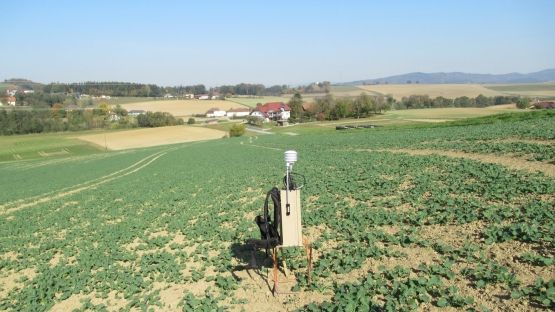Enhancing Agricultural Resilience & Water Security with Cosmic Ray Neutron Sensor (Research Project)
Published on by Water Network Research, Official research team of The Water Network in Academic
New Coordinated Research Project (IAEA Department of Nuclear Sciences and Applications)
- Enhancing Agricultural Resilience and Water Security Using Cosmic Ray Neutron Sensor

Soil moisture heterogeneity mapping in Petzenkirchen (research station of Austrian Institute for Land and Water Management Research) using backpack CRNS. (Photo: E. Fulajtar/IAEA)
The effects of climate change and population growth are posing major challenges to agricultural productivity and increasing the vulnerability of food and agricultural systems. Sustaining agricultural productivity, requires the efficient management of agricultural water resources, which involves a clear understanding of the temporal dynamics and spatial variability of soil moisture. The measurement and understanding of these dynamics are essential to irrigation management, water use efficiency, water conservation, drought management and flood forecasts, and other production inputs such as fertilizers application and pumping energy. The prerequisite is reliable soil moisture data, measured at a large-scale and in real-time.
Unfortunately, conventional methods of soil moisture measurement and monitoring provide point data only and do not cover large areas. Furthermore, their set-up in agricultural fields is limited by the tillage and other land management operations and farming practices. To overcome these operational challenges, the Cosmic-Ray Neutron Sensor (CRNS) is a credible and robust alternative, offering many advantages: it is contactless, it detects soil moisture over large areas, and its set-up is not cumbersome. The major advantages of the CRNS are its large horizontal footprint (tens of hectares) and the penetration depth of tens of centimetres (reaching root zone in most cases). Another alternative to conventional methods, and a complementary tool to CRNS, is the Gamma Ray Spectrometer (GRS): it provides medium-scale soil moisture data, with a relatively smaller foot print (radius of approximately 25 m) and shorter penetration depth (10 - 30 cm) than CRNS. It is best suited and adapted to highly heterogeneous agricultural landscapes such as areas with small family farming or areas of mountainous agriculture.
The Joint FAO/IAEA Division of Nuclear Techniques in Food and Agriculture is launching a new Coordinated Research Project (CRP) titled ‘Enhancing agricultural resilience and water security using Cosmic-Ray Neutron Sensor’ to use the CRNS and the GRS to measure, assess and monitor soil moisture for the purpose of agricultural water management: irrigation scheduling, management of extreme weather events (flood and drought), and development of climate change resilience strategies.
The overall objective of CRP is ‘Establishing landscape soil moisture sensing using CRNS for improving agricultural water management practices and climate resilience strategies’.
The specific objectives are:
- Advancing the capabilities of CRNS for Best Management Practices in irrigated and rainfed agricultural production systems;
- Integrating CRNS, GRS, remote sensing and hydrological modelling for improving agricultural water management and agriculture production resilience at regional scales;
- Developing approaches, using CRNS and GRS, for long-term soil moisture monitoring in agricultural systems and early warning systems for flood and drought management.
The CRP is seeking project partners from the fields of earth and agricultural sciences, with expertise and experience in agriculture soil water studies (soil moisture measurement, soil moisture dynamics, irrigation scheduling, hydrological modelling, soil moisture assessment using remote sensing, drought monitoring and predicting and flood forecasting) to address this CRP’s research objectives and expected outcomes. It is required that the project partners have functioning CRNS and basic skills in running CRNS soil moisture measurements.
How to join this CRP:
In total 6 research and 3 technical contracts and 3 agreements will be awarded in this CRP. Researchers with formulated programmes in agriculture soil moisture management having CRNS and technical capacity to carry out CRNS soil moisture measurements and to meet the objectives of the proposed CRP are invited to apply.
Submit your Proposal for Research Contract or Agreement by email, no later than 3 May 2019, to the IAEA’s Research Contracts Administration Section, using the appropriate template on the CRA web portal. Note that the same template can be used for the research contract and technical contract. For further information related to this CRP, potential applicants should use the contact form under the CRP page.
Source: IAEA
Media
Taxonomy
- Sustainable Agriculture
- Soil
- Food Security
- Water Efficiency
- Water Security
- Sensor Systems
- Climate Change
- Climate Change Adaptation
- Water Security
- Climate Change Resilience
- Water Security
- Soil & Water Assessment Tools
- Sustainable Agriculture
- Water Resources Engineering
- Water Resources Management
- Soil Management
- Soil Conservation
- Soil Carbon
- Agricultural Technology
- ICT for Agriculture & Forestry
- Remote Sensing
- Soil-less Agriculture
- Water-Energy-Food Security
- water management and technology evaluation, climate change